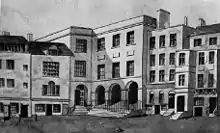Great Synagogue of London
The Great Synagogue of London was, for centuries, the centre of Ashkenazi synagogue and Jewish life in London. Built north of Aldgate in the 17th century, it was destroyed during World War II, in the Blitz.
| Great Synagogue of London | |
|---|---|
.jpg.webp) The Great Synagogue in 1809 (from Ackerman's Microcosm of London) | |
| Religion | |
| Affiliation | Judaism |
| Rite | Ashkenazi |
| Status | Destroyed |
| Location | |
| Location | London, England |
| Architecture | |
| Architect(s) | James Spiller |
| Completed | 1790 |
History
The earliest Ashkenazi synagogue constructed in London, after the return of Jews to England in the 17th century, was built about 1690 at Duke's Place, north of Aldgate, in the City of London. In 1696–7, the synagogue also acquired a burial ground, at Alderney Road.[1]
The congregation grew, and in 1722 a new building was erected with the cost of £2,000 (equivalent to £330,000 in 2021) being borne by businessman and philanthropist Moses Hart. The building was consecrated on Rosh Hashana (September 18, 1722).[2] An enlarged building, designed by George Dance the Elder, was consecrated on August 29, 1766. The order of prayers for the inauguration was the first printed publication of the synagogue, and also the first publication to name it explicitly as 'The Great Synagogue'.[3]
Between 1788 and 1790, the third synagogue was built on the site. Unusually for the time, the principal donor was a woman, Judith Levy, a daughter of Moses Hart, who subscribed £4,000 (equivalent to £540,000 in 2021).[4] The architect was James Spiller. The building was in the classical style identified with John Adam. It was redecorated and repaired in 1832 and 1852 by John Walen, and restored again with small renovations in 1899 and 1930.[5]
The Royal Dukes of Cambridge, Cumberland, and Sussex, sons of George III, visited the Great Synagogue of London in 1809. There they were seated on elegant Egyptian revival chairs as they watched the religious service.[6] The synagogue was also visited around this period, during his schooldays, by the writer Leigh Hunt, who wrote 'I took pleasure in witnessing the semi-Catholic pomp of their service and in hearing their fine singing, not without something of a constant astonishment at their wearing their hats'.[7]

The synagogue was destroyed during the night of May 10/11, 1941, during one of the last major attacks of the Blitz.[8] A plaque commemorating the synagogue is placed on Duke's Place.[9]
Rabbis

The rabbis of the Great Synagogue, and their terms of office,[10] included:
- Judah Loeb Cohen, 1696–1700
- Aaron the Scribe of Dublin (acting rabbi) (1700-c. 1704)
- Aaron Hart, c. 1704–1756
- Hart Lyon, 1758–1764
- David Tevele Schiff, 1765–1792
- Moses Myers (acting rabbi) 1792–1802
- Solomon Hirschell, 1802–1842
- Nathan Marcus Adler, 1845–1890
- Hermann Adler, 1891–1911
- Joseph Hertz, 1913–1946
Cantors

Myer Lyon was hazzan at the Synagogue from 1767. For some time he also doubled as an opera singer at Covent Garden Theatre under the name 'Michael Leoni'. His rendering of prayers attracted many gentile visitors to the synagogue; amongst them was the Methodist minister Thomas Olivers, who adapted Leoni's rendition of the prayer Yigdal to create the English hymn, The God of Abram Praise; its melody still bears the title Leoni in Hymns Ancient and Modern.[11]
From his arrival in England until his death in 1880 the Anglo-Jewish composer of synagogue music Julius Mombach was associated with the Great Synagogue. He arrived in 1827 as meshorrer (choirboy) and eventually became the Synagogue's choir master.
In art
In 1819 an aquatint of the interior was drawn by Augustus Charles Pugin and Thomas Rowlandson, and originally published in the popular illustrated magazine of the period, Ackermann's Repository of Arts. Pugin drew a handsome representation of the Ionic columns supporting the balconies and the classical decoration of the building. Rowlandson drew caricatures of the congregants, with the hunched shoulders and exaggerated noses traditionally attributed to Jews.[12]
References
- Notes
- Roth (1950) 11–18
- Roth (1950), 50–51
- Roth (1950) 131
- Roth (1950) 163-6
- Krinsky (1996)pp. 415ff.; Kadish (1996), Chapter 4, by Clarence Epstein, The Architecture of the Great Synagogue, Duke's Place
- Wischnitzer, p. 169.
- cited in Roth (1950), 170
- "The former Great Synagogue". Jewish Communities & Records U.K. JewishGen. 2003. Retrieved 14 June 2020.
- "Great Synagogue, Dukes Place".
- Roth (1950), 301–2
- Conway (2012), p. 76
- Krinsky, (1996),p. 417
- Sources
- Conway, David (2012). Jewry in Music: Entry to the Profession from the Enlightenment to Richard Wagner. Cambridge: Cambridge University Press. ISBN 978-1107-01538-8
- Kadish, Sharman (1996). Building Jerusalem, Jewish Architecture in Britain, London: Valentine Mitchell
- Krinsky, Carol H., Synagogues of Europe; Architecture, History, Meaning, MIT Press, 1985; revised edition, MIT Press, 1986; Dover reprint, 1996
- Roth, Cecil (1950). The Great Synagogue London 1690–1940. London; (available in an online version here)
{{cite book}}: External link in|postscript= - Wischnitzer, Rachel, (1964). The Architecture of the European Synagogue. Jewish Publication Society of America.
External links
- The Great Synagogue on Jewish Communities and Records – UK (hosted by jewishgen.org).
- Great Synagogue Records on [http://www.synagoguescribes.com/blog/ SynagogueScribes One Stop gateway to Anglo Jewish Records - UK